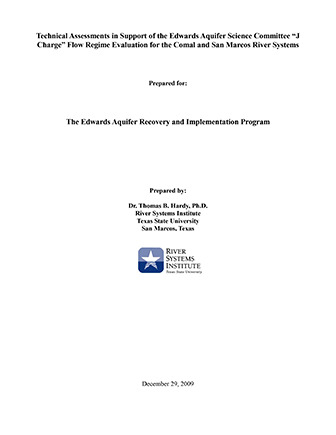Technical Assessments in Support of the Edwards Aquifer Science Committee “J Charge” Flow Regime Evaluation for the Comal and San Marcos River Systems

| Author | Hardy TB (Texas State University, River Systems Institute) |
| Year | 2009 |
| Description | Modeling for critical flow requirements to protect endangered species in the Comal and San Marcos Rivers |
| Publisher | Texas State University, River Systems Institute |
| Location | Comal River, San Marcos River |
| Cover | View Download |
| File | View Download |
| Summary |
|
This report summarizes the technical analysis of the flow dependent characteristics of physical habitat for target aquatic species within the Comal and San Marcos Rivers to support the Science Committee of the Edwards Aquifer Recovery Implementation Program in development of their recommendations for flow regimes under Senate Bill 2 ‘J Charges’. Target species were fountain darter (Etheostoma fonticola), Texas wild rice (Zizania texana), and the Comal Springs riffle beetle (Heterelmis comalensis). In addition, qualitative assessments of other native and non-native species as well as recreation were considered. A team of private, state, federal, and university researchers knowledgeable with the target species and in particular, the Comal and San Marcos River systems were used to develop influence diagrams for the three target species to aid the evaluation of both intrinsic and extrinsic factors that affect the persistence of these target species. The team also used these diagrams to evaluate existing data and specific modeling approaches to aid in their evaluations of flow regimes for each river system. As part of this process, the team considered other factors such as non-native species of plants and animals, parasites, recreation, and anthropogenic impacts due to watershed development. Historical research and existing physical, chemical, and biological monitoring data collected through 2009 from both the Comal and San Marcos Rivers were integrated to develop biological response functions for factors such as depth, velocity, substrate/vegetation use, water temperatures, etc. Habitat suitability curves were reviewed for fountain darters, Texas wild rice, and Comal Springs riffle beetles based on new data collected over the past eight years. Existing monitoring data were used to update the fountain darter habitat suitability curves for depth and velocity. No modifications were made to the Texas wild rice habitat suitability curves and as noted below, simulations of available habitat for the Comal Springs riffle beetle relied on a simplified surface area analysis as well as an alternative analysis based on data collected during the original Comal River studies. Vegetation maps relied upon those derived from the original studies conducted in the Comal and San Marcos due to lack of system-wide revised vegetation mapping data being available. These existing or revised habitat suitability curves for the target species, in conjunction with the two-dimensional hydrodynamic models for each river and associated one-dimensional water quality/temperature models for the Comal and San Marcos Rivers were used to predict the location and quality of wild rice, fountain darter, and riffle beetle habitat as a function of different flow ranges in each river system. No new water quality modeling was undertaken and the report relied upon the previous modeling results for both river systems. Model sensitivity to changes in channel topographies and habitat suitability curves for depth and velocity for fountain darters were also explored. Updated modeling results show that the largest difference in the habitat versus flow relationships for fountain darters were attributed to differences in habitat suitability curves. Modeling of fountain darter habitat for pre versus post 1998 flood induced channel changes in the San Marcos River primarily resulted in a scaling of the magnitude of predicted available habitat rather than a substantive change in the functional relationship. In both the San Marcos and Comal River systems, potentially adverse thermal conditions may begin to limit darter larval survival under very low flow conditions. Modeling results for Texas wild rice in the San Marcos River suggest that habitat availability begins to decline below about 65 cfs with increasing risk to physical disturbance and drying, especially at and below 30 cfs. The modeling results also suggest that protection of Texas wild rice would likely ensure protection for the other target species such as fountain darters. Modeling results for the Comal Springs riffle beetle based on total surface area in the main spring runs (i.e, 1,2, and3) were somewhat insensitive to modeled total Comal flow rates as low as 30 cfs. However, maintaining spring run flows provides the most conservative strategy as it provides the best overall protection for the other flow dependent aquatic resources such as fountain darters and other native species. Based on modeling results and analysis, recommendations are made for future work in light of the on-going data collection and modeling in support of the Edward Aquifer Habitat Conservation Plan. Although this report provides the technical documentation on modeling approaches and summary results, no specific flow recommendations are made. The Science Committee of the Edwards Aquifer Recovery Implementation Program will recommend target flow regimes for each river system. |
Search for Documents
Advance Search
Explore EAA's Scientific Reports
- All Reports
- Weather Modification
- Geology
- Water Use and Conservation
- Geochemistry
- Water Resources Planning and Management
- Floods and Drought
- Water Quality
- Climatology
- Surface Water / Groundwater Relationship
- Biology
- Springs, Groundwater Discharge
- Archaeology
- RZ Protection
- Aquifer Levels
- Remote Sensing
- Precipitation
- Overview Studies
- Modeling
- Hydrology and Hydrogeology
- History
- Groundwater Recharge, Recharge Zone
- Groundwater Movement
- Geomorphology and Caves
